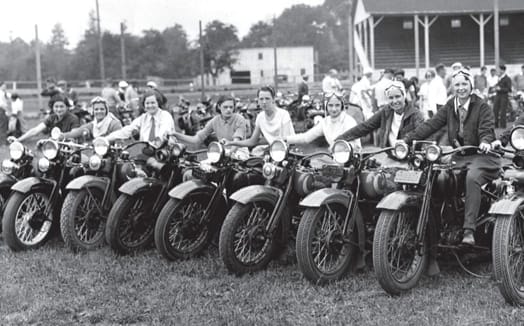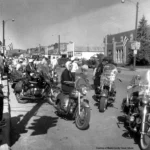Hey there, gearheads and history buffs! Let’s hop on a wild ride through the decades, exploring the legendary Sturgis Bike Rally. From its humble beginnings as a small-town gathering to the roaring extravaganza it is today, this rally has become a beacon for motorcycle enthusiasts worldwide. We’ll dive into its captivating origins, trace its incredible evolution, and explore the cultural and economic impact that has made Sturgis a must-see event for anyone with a thirst for adventure.
History of the Sturgis Bike Rally
The Sturgis Motorcycle Rally, a name synonymous with roaring engines and a celebration of motorcycle culture, has a rich and fascinating history. What began as a modest gathering in 1938 has evolved into a global phenomenon, drawing hundreds of thousands of motorcycle enthusiasts to Sturgis, South Dakota, every year.
From Humble Beginnings to a Roaring Tradition
The seed for the Sturgis Bike Rally was planted in 1938 by Edwin “Pappy” Hoel, a local Indian Motorcycle dealer with a passion for motorcycles and a vision for bringing fellow enthusiasts together. This first iteration, dubbed the “Black Hills Classic,” was a three-day affair featuring thrilling races, captivating stunts, and a shared love for all things motorcycles.
As the rally gained traction, its duration expanded, eventually evolving into the ten-day spectacle it is today. Hillclimb and Motocross races were added to the roster, amping up excitement and drawing even larger crowds. By 2017, the rally had grown to accommodate the ever-increasing influx of bikers, solidifying its status as a must-attend event for motorcycle enthusiasts worldwide.
More Than Just a Rally: A Boost for the Local Economy and Culture
The impact of the Sturgis Motorcycle Rally extends far beyond the roar of engines and the camaraderie of riders. The event has become a significant economic driver for the Black Hills region, injecting an estimated $800 million into the local economy annually. This influx of revenue is a testament to the rally’s immense drawing power, attracting over 700,000 visitors who contribute to the region’s prosperity.
Beyond its economic impact, the rally has become deeply intertwined with the cultural fabric of the Black Hills. The annual gathering brings together a diverse tapestry of riders, united by their shared passion for motorcycles and the open road. This melting pot of cultures and backgrounds creates a vibrant and inclusive atmosphere that celebrates the spirit of freedom and adventure embodied by motorcycle culture.
United by Chrome and Camaraderie
The Sturgis Bike Rally is more than just a gathering of motorcycles; it’s a vibrant tapestry of subcultures, traditions, and shared passions. The event showcases the artistry and craftsmanship of motorcycle customization, with dazzling displays of unique bikes reflecting their owners’ personalities and passions.
At its core, Sturgis is about camaraderie – the bonds forged on the open road and the shared love for the two-wheeled machines that bring riders together. From jaw-dropping bike shows to electrifying concerts that keep the energy high, the Sturgis experience offers something for everyone who shares a love for motorcycles and the spirit of the open road.
Riding Towards a Greener Future
In recent years, there has been growing awareness surrounding the environmental impact of large gatherings like Sturgis. Rally organizers have responded proactively, implementing various initiatives to promote sustainability. These include comprehensive recycling programs, robust waste reduction measures, and a conscious effort to minimize the rally’s overall environmental footprint. Sturgis has also become a platform for promoting motorcycle safety, encouraging responsible riding practices, and fostering a culture of awareness among its attendees.
The Sturgis Bike Rally stands as a testament to the enduring spirit of motorcycle enthusiasts, evolving over the decades while staying true to its roots. It’s a celebration of freedom, camaraderie, and the unbridled joy of the open road, leaving an unforgettable mark on the Black Hills of South Dakota and the hearts of those who experience its magic.
How did the Sturgis Bike rally begin?
The Sturgis Bike Rally, a behemoth in the world of motorcycle events, has a surprisingly humble origin story. It all began in 1938 in the heart of Sturgis, South Dakota, when a man named Edwin “Pappy” Hoel, a local Indian Motorcycle dealer, decided to organize a gathering for motorcycle enthusiasts.
Hoel, fueled by his love for motorcycles and his desire to share that passion with others, envisioned an event that would celebrate the thrill of riding and the camaraderie it fostered. Thus, the “Black Hills Classic” was born, a three-day event featuring races, stunts, and a celebration of all things motorcycle.
Little did Hoel know that his small gathering would evolve into the globally renowned Sturgis Bike Rally we know today. Year after year, the rally’s popularity grew, attracting motorcycle aficionados from far and wide. What began as a local gathering transformed into a ten-day spectacle, drawing hundreds of thousands of attendees and etching its name into motorcycle history.
The Sturgis Bike Rally is about much more than just motorcycles; it’s a cultural phenomenon that celebrates freedom, adventure, and the shared love of the open road. It’s a melting pot of cultures, backgrounds, and personalities, all drawn together by the allure of motorcycles and the camaraderie they inspire.
The event’s impact extends beyond its cultural significance, injecting a substantial financial boost into the Black Hills region. The rally’s economic contributions are undeniable, with local businesses and the state economy reaping the benefits of the massive influx of visitors.
Of course, an event of this magnitude necessitates a strong emphasis on safety. Organizers work diligently to ensure the well-being of all attendees, implementing measures to mitigate risks and promote responsible riding practices. The rally’s commitment to safety highlights the organizers’ dedication to creating a positive and memorable experience for everyone involved.
What Makes the Sturgis Bike Rally Special?
- Motorcycle Races: From adrenaline-pumping dirt track races to the challenging hill climb, there’s a race for every thrill-seeker.
- Custom Bike Shows: Prepare to be amazed by the artistry and craftsmanship of custom motorcycle designs, each one a testament to the owner’s passion and creativity.
- Live Music: Rock out to legendary bands and discover new favorites with a diverse lineup of live music performances throughout the rally.
- Stunt Shows: Hold your breath as skilled riders defy gravity with death-defying stunts, showcasing the limits of motorcycle agility and control.
- Poker Runs: Combine your love for motorcycles with a little friendly competition in organized poker runs, traversing scenic routes and testing your luck.
- Bike Parades: Join thousands of fellow riders as you cruise through the picturesque Black Hills, creating a spectacle of chrome and leather against a backdrop of natural beauty.
- Food & Drinks: Indulge in delicious food, ice-cold drinks, and good company at the rally’s numerous food stalls and vendors.
- Vendor Village: Shop ’til you drop for motorcycle gear, apparel, souvenirs, and more in the sprawling vendor village, offering a wide array of biker-themed merchandise.
The Sturgis Bike Rally is a testament to the enduring appeal of motorcycle culture and the spirit of adventure it embodies. From its humble beginnings to its current status as a global phenomenon, the rally continues to captivate and inspire, drawing in motorcycle enthusiasts and curious onlookers alike. It’s an experience that celebrates freedom, camaraderie, and the timeless allure of the open road.
Why is Sturgis so famous?
The Sturgis Motorcycle Rally isn’t just another event; it’s a cultural phenomenon that captures the spirit of freedom, camaraderie, and the allure of the open road. But what exactly is it about this annual gathering in South Dakota that draws people from all walks of life?
- A Global Mecca for Motorcycle Enthusiasts: Sturgis holds the title of the largest motorcycle rally on the planet. Every August, this small town transforms into a haven for bikers and motorcycle enthusiasts, creating an unparalleled experience of camaraderie and shared passion. It’s a melting pot of motorcycle cultures, united by the love of riding and the thrill of the open road.
- The Allure of the Black Hills: The stunning backdrop of the Black Hills adds to the allure of Sturgis. Imagine cruising on your bike, wind in your hair, surrounded by towering pine trees and scenic roads that stretch as far as the eye can see. The rally’s location offers breathtaking views and unforgettable riding experiences.
- More Than Just Bikes: While motorcycles are undoubtedly the main attraction, Sturgis offers a festival atmosphere that goes beyond the world of two wheels. From adrenaline-pumping races and mind-blowing stunt shows to electrifying concerts and a vibrant vendor scene, there’s something for everyone to enjoy.
- Steeped in History and Tradition: The Sturgis Bike Rally isn’t just a fleeting trend; it’s an event steeped in history and tradition. Since its inception in 1938, the rally has evolved into a cherished tradition, a pilgrimage for those who live and breathe motorcycle culture. It represents the enduring spirit of motorcycling and the freedom it represents.
The Sturgis Motorcycle Rally is more than just an event; it’s an experience. It’s an opportunity to connect with like-minded individuals, immerse yourself in a vibrant culture, and create memories that will last a lifetime. It’s a reminder that some traditions never fade, they just become more exciting and unforgettable with each passing year.
What is the history of the Jack Pine Gypsy Club?
The Jack Pine Gypsy Club (JPGC), deeply intertwined with the history of the Sturgis Motorcycle Rally, embodies the spirit of camaraderie, adventure, and passion for motorcycles that defines the iconic event. Founded in 1936, the club’s story is a testament to the enduring power of shared interests and the impact a group of passionate individuals can have.
Origins and Identity:
The JPGC’s roots lie in the rugged beauty of the Black Hills, where the club’s founders, united by their love for motorcycles, found solace and thrill riding through the towering Ponderosa pines. The name “Jack Pine Gypsy” reflects their connection to this unique landscape and their free-spirited, adventurous nature, reminiscent of the wandering Gypsies.
Pappy Hoel: A Pivotal Figure:
Among the JPGC’s ranks was a man named “Pappy” Hoel, whose name would become synonymous with the Sturgis Motorcycle Rally itself. In 1938, Hoel, an Indian Motorcycle dealer, offered up his land as the first official gathering spot for what would evolve into the legendary Sturgis Rally. This act of generosity cemented his place in motorcycling history and provided a welcoming space for like-minded individuals to connect, share stories, and forge lasting bonds.
Champions of Inclusivity:
The JPGC’s impact extends beyond their role in the rally’s genesis; they were staunch advocates for inclusivity within the motorcycle community. In the 1970s and 1980s, when certain city officials attempted to ban “1% clubs” (motorcycle clubs often associated with outlaw biker culture) from the rally, the JPGC stood firm in their opposition. They believed that all motorcycle enthusiasts, regardless of affiliation, had the right to participate in the rally, challenging the proposed restrictions as discriminatory and antithetical to the event’s spirit of camaraderie.
The JPGC’s unwavering commitment to inclusivity played a pivotal role in shaping the Sturgis Rally into the welcoming and diverse event it is today. Their story reminds us that shared passions can bridge divides and create a sense of community that transcends backgrounds and beliefs. The JPGC’s legacy lives on in the spirit of the Sturgis Rally, where riders from all walks of life come together to celebrate their love for motorcycles and the open road.
Do non-bikers go to Sturgis?
While the rumble of motorcycles might be the soundtrack to the Sturgis Motorcycle Rally, the event attracts more than just die-hard bikers. You might be surprised to learn that plenty of people who wouldn’t know a Harley from a Honda flock to Sturgis to experience the unique atmosphere and festivities.
Think of Sturgis as a giant county fair infused with a hearty dose of chrome and leather. It’s a spectacle that draws people from all walks of life – families on vacation, curious couples, groups of friends, and even those simply looking to experience the legendary event firsthand.
Beyond the Bikes:
Sturgis offers an array of attractions that cater to a wide range of interests:
- Vendor Haven: The rally boasts a sprawling vendor scene selling everything from handmade jewelry and leather goods to biker apparel and souvenirs.
- Live Music Galore: Live music spills out from almost every doorway, creating a vibrant and energetic atmosphere.
- Food, Glorious Food: The food stalls alone are worth the trip, offering a tantalizing array of culinary delights to satisfy every craving.
A Welcoming Atmosphere:
Don’t let the leather and tattoos fool you; Sturgis is known for its welcoming and inclusive atmosphere. It’s a place where people from all backgrounds come together to celebrate their love for motorcycles, music, and good times.
So, if you’re on the fence about attending Sturgis because you don’t ride a motorcycle, reconsider! You might be surprised at how much you enjoy the lively atmosphere, entertainment, and overall experience.
How much money does Sturgis Rally make?
The Sturgis Motorcycle Rally isn’t just a gathering of motorcycle enthusiasts; it’s an economic powerhouse for South Dakota, particularly for the Black Hills region. The influx of hundreds of thousands of visitors translates into a significant financial boost for local businesses and the state’s economy.
Estimating the Economic Impact:
While pinpointing the exact economic impact of an event as massive as the Sturgis Rally is a complex endeavor, estimates suggest that the rally generates approximately $800 million in revenue annually. This significant sum underscores the rally’s substantial economic influence.
Revenue Sources:
The rally’s revenue streams are diverse, encompassing various sectors:
- Lodging: Hotels, motels, and other accommodation providers experience a surge in bookings during the rally, generating substantial income.
- Food and Beverage: Restaurants, bars, and food vendors benefit from the increased demand for food and drinks, contributing to the rally’s economic impact.
- Retail: Souvenir shops, motorcycle dealerships, and other retail establishments witness a surge in sales as attendees indulge in retail therapy.
- Gas Stations: With attendees traveling from far and wide, gas stations experience a significant increase in fuel sales, further contributing to the rally’s economic impact.
Benefits Beyond Direct Spending:
The rally’s financial impact extends beyond direct spending:
- Tax Revenue: The state of South Dakota sees a boost in tax revenue from sales tax on purchases, lodging taxes, and increased gas sales.
- Job Creation: The rally creates seasonal job opportunities for locals, providing a temporary economic boost.
- Tourism: The Sturgis Motorcycle Rally puts South Dakota on the map for many visitors, attracting tourists throughout the year and boosting the state’s tourism industry.
The Sturgis Motorcycle Rally is not only a celebration of motorcycle culture but also a vital economic engine for South Dakota. Its ability to generate revenue, create jobs, and attract tourists solidifies its position as a significant contributor to the state’s economic well-being.
How Much Does it Cost to Go to Sturgis Bike Week?
Planning a trip to the legendary Sturgis Bike Rally requires careful budgeting, as the costs associated with this epic gathering can add up quickly. While the experience is undoubtedly priceless, understanding the potential expenses can help you plan a trip that aligns with your financial goals.
Factors Influencing Costs:
Several factors influence the overall cost of attending Sturgis Bike Week:
- Distance: Your proximity to Sturgis will impact your travel expenses, particularly gas prices for those riding their motorcycles.
- Lodging: Accommodation costs can vary greatly depending on your preferences and booking timeline.
- Lifestyle: Your spending habits on food, drinks, entertainment, and souvenirs will also influence your overall budget.
Estimated Costs:
Here’s a breakdown of estimated costs to give you a general idea:
- Fuel: Gas prices fluctuate, but assuming an average price per gallon, you can estimate your fuel costs based on your motorcycle’s fuel efficiency and the distance you’ll be riding.
- Motorcycle Maintenance: Before embarking on a long journey, it’s wise to factor in potential motorcycle maintenance costs, including oil changes, tire checks, and any necessary repairs.
- Lodging: Camping is often the most budget-friendly option, with prices ranging from $20 to $30 per night. However, if comfort and convenience are priorities, hotel rooms can range from $100 to $300 per night, especially during the rally.
- Food and Drinks: Eating out for every meal can quickly deplete your budget. Packing snacks, drinks, and even preparing some meals at your campsite can help cut down on food expenses.
- Entertainment: Sturgis offers a plethora of entertainment options, from concerts and races to stunt shows and other attractions. Costs vary, so it’s best to research beforehand and budget accordingly.
- Souvenirs: It’s easy to get caught up in the excitement of the rally and overspend on souvenirs. Setting a budget for souvenirs can help prevent overspending.
Tips for Managing Costs:
- Plan Ahead: Booking accommodations and securing event tickets in advance can often save you money.
- Consider Alternatives: Explore lodging options in nearby towns or campgrounds for potentially lower rates.
- Set a Budget: Determine how much you’re comfortable spending and track your expenses throughout the rally.
- Pack Smart: Bringing essentials like sunscreen, rain gear, and a first-aid kit can save you from last-minute purchases.
Attending Sturgis Bike Week doesn’t have to break the bank. With careful planning, budgeting, and a focus on maximizing experiences while minimizing unnecessary costs, you can enjoy this epic gathering without financial stress.
What percentage of bikes at Sturgis are Harleys?
Harley-Davidson motorcycles have long been synonymous with the Sturgis Motorcycle Rally, their iconic rumble seemingly echoing through the Black Hills every August. But with the evolving landscape of the motorcycle world and the increasing diversity of riders, it’s natural to wonder what percentage of bikes at Sturgis actually bear the Harley-Davidson emblem.
Harley’s Reign, But Shifting Tides:
A 2015 study revealed that a significant 64% of motorcycles present at the Sturgis Rally were Harley-Davidsons. This figure highlights the brand’s deep-rooted connection to the rally and its enduring popularity among motorcycle enthusiasts. However, it’s important to note that this data is from several years ago, and the motorcycle landscape has undergone significant shifts since then.
Evolving Demographics and Brand Diversity:
The motorcycle community is experiencing a surge in younger riders, a trend reflected in the changing demographics of the Sturgis Rally. This new generation of riders is drawn to a wider range of motorcycle brands, embracing diversity and challenging the traditional dominance of Harley-Davidson.
Challenges in Determining Exact Percentages:
Accurately determining the current percentage of Harleys at Sturgis is challenging due to several factors:
- Attendance Fluctuations: Attendance numbers vary from year to year, making it difficult to establish a consistent baseline.
- Rider Mobility: Attendees don’t just stay in Sturgis; they venture out to explore the surrounding Black Hills, making it difficult to obtain a comprehensive count at any given time.
- Data Collection Methods: Official attendance numbers often rely on vehicle sensors, which don’t differentiate between motorcycle brands.
The Future of Motorcycle Diversity:
While Harley-Davidson undoubtedly maintains a significant presence at the Sturgis Motorcycle Rally, the evolving demographics of riders and the increasing popularity of other motorcycle brands suggest that the percentage of Harleys might be shifting.
The Sturgis Motorcycle Rally, like the motorcycle world itself, is in a constant state of evolution. While Harley-Davidson’s legacy is undeniably intertwined with the event, the future likely holds a more diverse representation of motorcycle brands, reflecting the changing tastes and preferences of riders worldwide.
Is Sturgis Kid Friendly?
The Sturgis Motorcycle Rally, often associated with its adult-oriented festivities, might not immediately come to mind as a family-friendly destination. However, with careful planning and consideration, it’s possible to create a memorable and enjoyable experience for attendees of all ages, even the youngest motorcycle enthusiasts in the making.
Navigating the Rally with Children:
Here are some tips for making Sturgis a family-friendly experience:
- Timing is Key: Consider attending the rally during weekdays or shoulder seasons (early August or after the main rally week) when crowds are generally smaller.
- Strategic Accommodation: Opt for lodging options further away from the heart of the rally, where you’re more likely to find a peaceful and family-friendly atmosphere.
- Embrace Daytime Activities: Focus on the numerous daytime events and attractions that cater to families, such as the Sturgis Motorcycle Museum & Hall of Fame, scenic rides through the Black Hills, and local parks.
- Pack Wisely: Be prepared for unpredictable weather with layers of clothing, rain gear, sunscreen, and hats.
Family-Friendly Attractions:
Sturgis and the surrounding Black Hills region offer a range of attractions that appeal to all ages:
- Sturgis Motorcycle Museum & Hall of Fame: This museum showcases the history of motorcycles, featuring vintage bikes, exhibits, and interactive displays.
- Days of ’76 Museum: Step back in time and learn about the Wild West history of the Black Hills at this museum, featuring exhibits on pioneers, gold miners, and Native American culture.
- Bear Country USA: Get up close and personal with North American wildlife, including bears, wolves, and elk, at this drive-through wildlife park.
- Custer State Park: Explore the scenic beauty of Custer State Park, home to granite peaks, rolling hills, sparkling lakes, and abundant wildlife.
Open Communication and Realistic Expectations:
Before attending Sturgis with children, have open and honest conversations about what to expect. Explain that while there will be lots of motorcycles, there will also be large crowds, loud noises, and a party atmosphere that might not be suitable for young children, especially at night.
With careful planning, realistic expectations, and a focus on family-friendly activities, it’s possible to create a positive and memorable Sturgis experience for everyone, ensuring that even the youngest attendees catch the motorcycle bug.
What is the largest motorcycle rally in the United States?
The title of the largest motorcycle rally in the United States goes to the legendary Sturgis Motorcycle Rally, held annually in Sturgis, South Dakota. This iconic event attracts over half a million attendees each year, transforming the usually quiet town into a thundering celebration of motorcycle culture, camaraderie, and the spirit of the open road.
Sturgis: A League of Its Own:
The Sturgis Motorcycle Rally’s reputation precedes it, drawing in motorcycle enthusiasts from every corner of the globe. The sheer scale of the event sets it apart, with attendees experiencing a sea of chrome and leather as far as the eye can see.
Beyond the Numbers:
Sturgis’s allure extends beyond its impressive attendance figures. The rally offers a unique blend of:
- Camaraderie: Bikers from all walks of life come together, sharing stories, admiring each other’s bikes, and forging connections based on their shared passion.
- Scenery: The scenic beauty of the Black Hills provides a breathtaking backdrop for rides and gatherings, adding to the overall experience.
- Entertainment: Sturgis offers a diverse range of entertainment options, from high-octane races and gravity-defying stunt shows to electrifying concerts and a plethora of vendor offerings.
- Tradition: With a history dating back to 1938, the Sturgis Motorcycle Rally has become a pilgrimage for motorcycle enthusiasts, a tradition that celebrates the enduring spirit of riding and the freedom it represents.
An Economic Powerhouse:
The Sturgis Motorcycle Rally isn’t just a cultural phenomenon; it’s an economic powerhouse for South Dakota and the Black Hills region. The massive influx of visitors translates into millions of dollars injected into the local economy, supporting businesses, creating jobs, and contributing to the state’s overall prosperity.
The Sturgis Motorcycle Rally’s status as the largest motorcycle rally in the United States is a testament to its enduring appeal, the camaraderie it fosters, and the unique blend of cultural significance and economic impact it delivers year after year.
How Did Daytona Bike Week Start?
Daytona Bike Week, another iconic name in the world of motorcycle rallies, has a rich history that dates back to the early days of motorcycle racing. What began as a single race in 1937 has evolved into a multi-event extravaganza that draws motorcycle enthusiasts to Daytona Beach, Florida, every year.
The Daytona 200: Igniting a Passion:
The genesis of Daytona Bike Week can be traced back to the inaugural Daytona 200 motorcycle race in 1937. This thrilling race, held on a unique course combining beach and pavement, captivated spectators and cemented Daytona Beach’s connection to motorcycle culture. Ed Kretz emerged victorious in this first race, achieving a record-breaking speed of 73.34 mph.
World War II Hiatus and the Unofficial Gathering:
The outbreak of World War II in 1942 brought the Daytona 200 to a halt, as resources and attention shifted towards the war effort. However, despite the official race’s suspension, motorcycle enthusiasts continued to flock to Daytona Beach, drawn by their shared passion for riding and the area’s allure. These informal gatherings during the war years kept the spirit of Daytona Bike Week alive and laid the groundwork for its resurgence.
Post-War Revival and the Rise of NASCAR:
With the war’s end in 1947, the Daytona 200 roared back to life, reclaiming its position as a premier motorcycle racing event. “Big Bill” France, one of the driving forces behind NASCAR, recognized the potential of the Daytona Bike Week festivities. France’s promotional prowess and NASCAR’s growing popularity helped elevate Daytona Bike Week into the major attraction it is today.
A Speedway is Born and a Second Festival Emerges:
The construction of the Daytona International Speedway in 1959 marked a turning point for Daytona Bike Week. This state-of-the-art facility became the new home of the Daytona 200, providing a world-class venue for the iconic race and further solidifying Daytona Beach’s status as a motorcycle mecca.
In 1991, the Daytona Beach Convention and Visitors Bureau introduced Biketoberfest, a second motorcycle festival held in October. This strategic move effectively extended the motorcycle season, giving enthusiasts another reason to visit Daytona Beach and experience the thrill of riding and camaraderie.
A Legacy of Passion and Evolution:
Daytona Bike Week’s journey from a single race to a multi-event spectacle is a testament to the enduring passion for motorcycles and the camaraderie they inspire. The event continues to evolve, embracing new trends and catering to a diverse community of motorcycle enthusiasts. From the roar of engines on the racetrack to the camaraderie shared among riders, Daytona Bike Week embodies the spirit of adventure and the timeless allure of the open road.
















